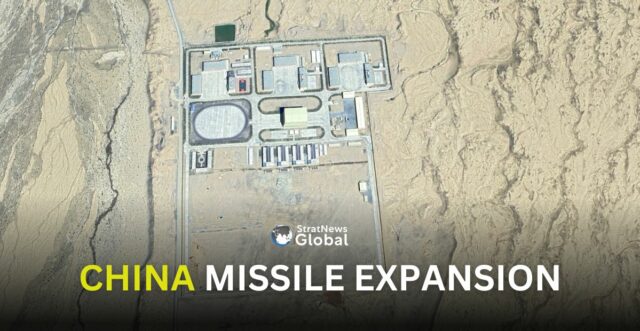China appears to be expanding its missile presence in western China’s Qinghai Province, with new satellite imagery revealing construction near Golmud city that analysts say could mark the establishment of another People’s Liberation Army Rocket Force (PLARF) brigade.
The development points to a growing military buildup on the Tibetan Plateau, heightening concerns in India about Beijing’s evolving deterrence posture along the contested border.
According to The Diplomat, the Golmud site—situated at high altitude on the Qinghai-Tibet Plateau—includes extensive new facilities such as large garages for transporter-erector-launchers (TELs), multiple concrete launch pads spread across desert terrain, and dome-shaped decoys designed to conceal activity from satellite observation. The layout is consistent with PLARF’s operational model for its road-mobile missile brigades. Construction began around 2020 and has accelerated since 2022, with imagery suggesting a growing network of launch and support buildings.
Analysts believe the new complex is likely under PLARF Base 64, headquartered in Lanzhou, which oversees missile operations in northwestern China. It could be linked to the 647th Missile Brigade already based in Xining—known to operate DF-26 intermediate-range ballistic missiles with an estimated range of up to 4,000 kilometers. The base may eventually deploy newer DF-27 missiles as well, extending China’s reach further into South and Southeast Asia.
The DF-26’s range allows it to target key Indian military facilities, including air bases in northern and eastern India, as well as logistics and naval hubs across the Indian Ocean region. Its dual capability—able to carry both conventional and nuclear warheads—adds a layer of uncertainty to crisis management and raises escalation risks in any confrontation between the two countries.
Indian defense experts have noted that the positioning of such systems in western China effectively broadens the PLA’s strike envelope toward the Line of Actual Control (LAC), providing Beijing with the ability to threaten India’s critical infrastructure without needing forward deployment near the border. The Golmud site’s elevation and road access also give China logistical flexibility to move launchers and supplies across the plateau rapidly, complicating Indian surveillance and deterrence planning.
The expansion aligns with Beijing’s broader effort to modernize its missile forces. In 2024, the U.S. Department of Defense estimated that China possessed about 250 DF-26 launchers—roughly seven brigades’ worth—and projected that its nuclear arsenal could reach 1,000 warheads by 2030. The Golmud construction, part of this wider modernization drive, reinforces China’s shift from older DF-21 medium-range systems to newer, dual-capable platforms designed for longer reach and greater mobility.
Local reports indicate that PLARF units have been conducting field exercises and high-altitude training in the Golmud region since mid-2024, supported by local civilian authorities. Officials in Golmud reportedly visited troops stationed or training in the area ahead of China’s Army Day last year, highlighting the city’s continuing role as a major military hub. Missile drills in Qinghai, Gansu, and Xinjiang were also reported in September 2024, possibly involving units from the new brigade.
For India, the growing Rocket Force footprint in western China underscores a shifting military balance in the Himalayas. While India has upgraded its own missile and surveillance capabilities and strengthened partnerships with the United States and other Indo-Pacific allies, Chinese missile deployments in Qinghai reduce warning times and expand Beijing’s strategic options in a crisis.
From a strategic standpoint, the Golmud development marks an evolution in China’s deterrence architecture—one that strengthens its second-strike capability and enhances its ability to apply pressure along multiple fronts. The new base also provides Beijing with greater operational depth, placing it beyond the reach of Taiwan’s or India’s existing missile systems.
For New Delhi, this expansion serves as a reminder of the rapidly changing dynamics on the plateau. As the PLARF consolidates its high-altitude launch network, India faces the challenge of recalibrating its own deterrence posture to address the growing missile asymmetry across the Himalayas.





